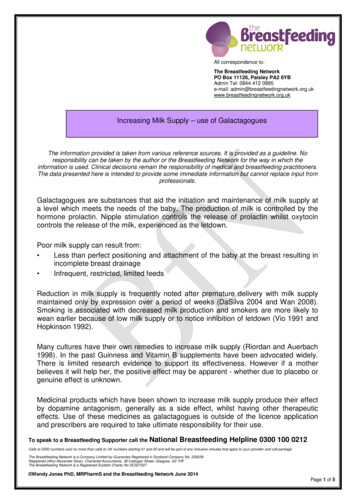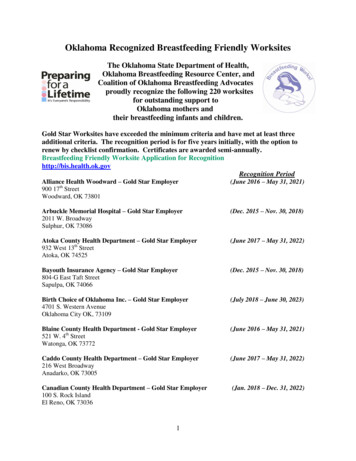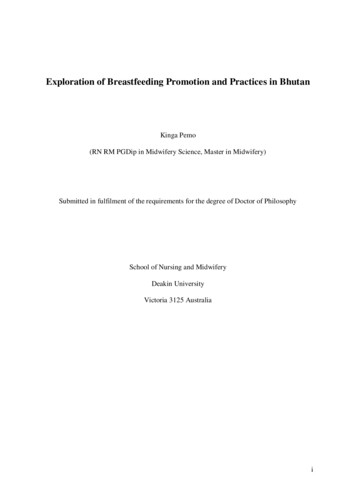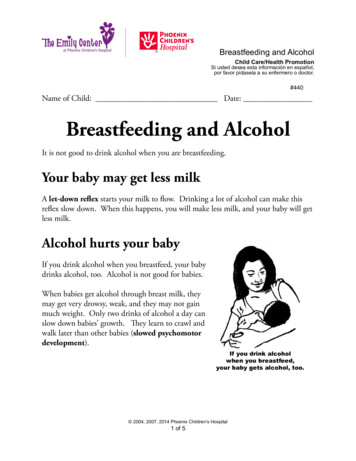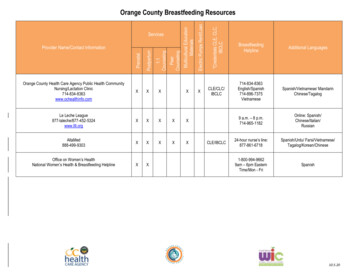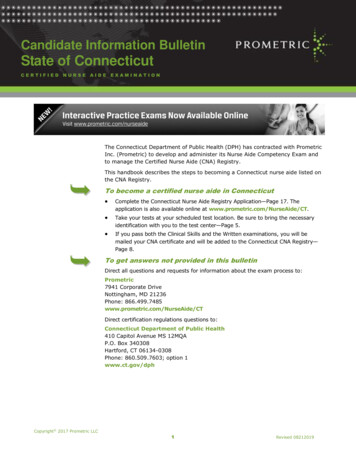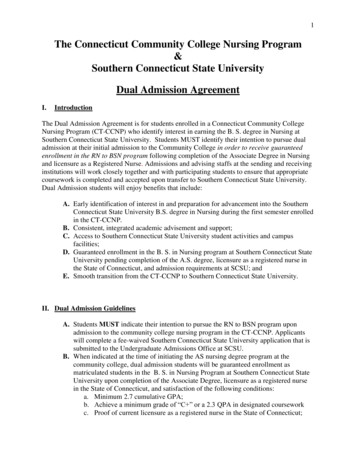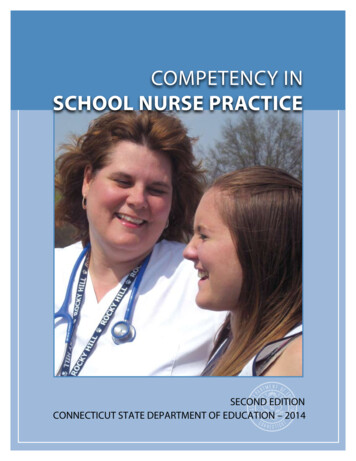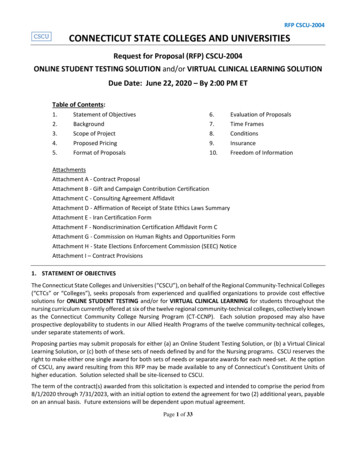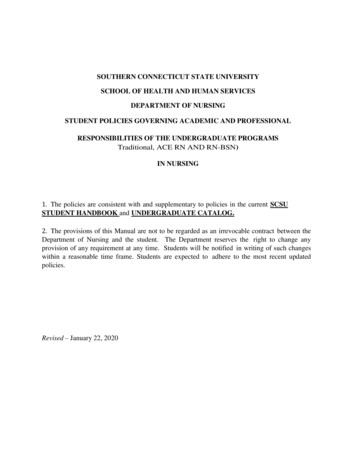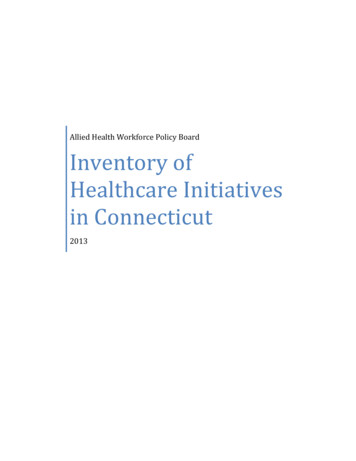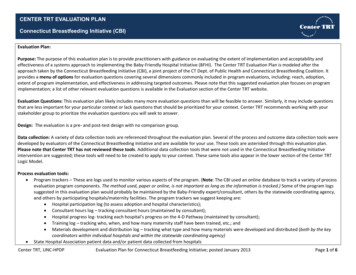
Transcription
CENTER TRT EVALUATION PLANConnecticut Breastfeeding Initiative (CBI)Evaluation Plan:Purpose: The purpose of this evaluation plan is to provide practitioners with guidance on evaluating the extent of implementation and acceptability andeffectiveness of a systems approach to implementing the Baby-Friendly Hospital Initiative (BFHI). The Center TRT Evaluation Plan is modeled after theapproach taken by the Connecticut Breastfeeding Initiative (CBI), a joint project of the CT Dept. of Public Health and Connecticut Breastfeeding Coalition. Itprovides a menu of options for evaluation questions covering several dimensions commonly included in program evaluations, including: reach, adoption,extent of program implementation, and effectiveness in addressing targeted outcomes. Please note that this suggested evaluation plan focuses on programimplementation; a list of other relevant evaluation questions is available in the Evaluation section of the Center TRT website.Evaluation Questions: This evaluation plan likely includes many more evaluation questions than will be feasible to answer. Similarly, it may include questionsthat are less important for your particular context or lack questions that should be prioritized for your context. Center TRT recommends working with yourstakeholder group to prioritize the evaluation questions you will seek to answer.Design: The evaluation is a pre- and post-test design with no comparison group.Data collection: A variety of data collection tools are referenced throughout the evaluation plan. Several of the process and outcome data collection tools weredeveloped by evaluators of the Connecticut Breastfeeding Initiative and are available for your use. These tools are asterisked through this evaluation plan.Please note that Center TRT has not reviewed these tools. Additional data collection tools that were not used in the Connecticut Breastfeeding Initiativeintervention are suggested; these tools will need to be created to apply to your context. These same tools also appear in the lower section of the Center TRTLogic Model.Process evaluation tools: Program trackers – These are logs used to monitor various aspects of the program. (Note: The CBI used an online database to track a variety of processevaluation program components. The method used, paper or online, is not important as long as the information is tracked.) Some of the program logssuggested in this evaluation plan would probably be maintained by the Baby-Friendly expert/consultant, others by the statewide coordinating agency,and others by participating hospitals/maternity facilities. The program trackers we suggest keeping are: Hospital participation log (to assess adoption and hospital characteristics); Consultant hours log – tracking consultant hours (maintained by consultant); Hospital progress log- tracking each hospital’s progress on the 4-D Pathway (maintained by consultant); Training log – tracking who, when, and how many maternity staff have been trained, etc.; and Materials development and distribution log – tracking what type and how many materials were developed and distributed (both by the keycoordinators within individual hospitals and within the statewide coordinating agency) State Hospital Association patient data and/or patient data collected from hospitalsCenter TRT, UNC-HPDPEvaluation Plan for Connecticut Breastfeeding Initiative; posted January 2013Page 1 of 6
Implementation Plan for Systems Approach to BFHIBFHI Maternity Staff Training curriculum (there are multiple options available to fulfill this requirement)Maternity Facility staff interview guide* – documents progress on five targeted steps, hospitals’ use of the trainer (for step 2), consultant hours used,policy changes, how the coordinating agency could have helped participating hospitals more.Baby-Friendly USA Self-Appraisal (CT used this appraisal tool and also created a “mock survey,” which was used at the end of the project, that wascreated from this self-appraisal tool and the consultant’s prior experience). Available here: overy(click on link to self-appraisal tool for PDF download of a sample).Short-term (1-3 year) outcome evaluation tools: Baby-Friendly USA Self-Appraisal Tool – overy (click on link to self-appraisal tool for PDF download) Maternity facility staff interview guide* Maternity staff survey* Mock survey Consultant logs (or electronic database) Baby-Friendly USA – Hospital Designation Tracker (official records of designations – see: http://www.babyfriendlyusa.org/eng/03.html)Tools that are asterisked were used by the CBI and are available for your use. These tools can be accessed on our website within the Evaluation Materialssection of the CBI Intervention Package. These tools were developed by an Evaluation Team based at PDA, Inc, which was contracted by the CBI to conduct theevaluation for the CBI’s BFHI project.Contact information for the developers is available on the Center TRT website within the CBI Intervention Package. Please contact the intervention developersfor questions about the intervention itself.Finally, the breastfeeding practices among mothers and babies were not measured in this evaluation. Here are some approaches to measuring these 010 Guidelines Criteria Rev%2011 28 11.pdf.PROCESS EVALUATIONThis section should address the reach of the intervention into the intended population; the adoption or uptake of the intervention by setting; and the fidelity ofimplementation of the intervention components and core elements.Evaluation QuestionsReachHow many and what were the characteristics of the staff reached by theCenter TRT, UNC-HPDPData to be Collected # of staff trainedEvaluation Plan for Connecticut Breastfeeding Initiative; posted January 2013Data Collection Method Training logPage 2 of 6
consultant-provided (or other options) of training? Demographics (hospital wherework, race, training level, positiontitle, etc.) Maternity staff survey*What proportion of maternity patients across the state were reached byhospitals/maternity facilities that had already achieved designation or wereactively working on achieving designation? # of women who give birth annuallyat all hospitals/ maternity facilitiesin state# of women who give birth annuallyat already BFHI designated facilitiesor those working on designation State HospitalAssociation patientdata and/or patientdata collected frommaternity facilities Demographics of women givingbirth in hospitals/maternityfacilities across the state comparedto demographics of women givingbirth in hospitals/facilities alreadydesignated or working towardsdesignation State HospitalAssociation patientdata and/or patientdata collected fromhospitals/maternityfacilities % of hospitals/maternity facilitiesinterested in participating in thetechnical assistance/trainingprogram (out of total number offacilities in state) State hospitalassociation dataHospital/maternityfacility participationlog (maintained bycoordinating agency)Existence of plan How representative of state-level demographics were the mothers and babiesreached by hospitals/maternity facilities already Baby-Friendly designated oractively working toward designation?AdoptionWhat proportion of hospitals/maternity facilities within the state adopted thetechnical assistance/training program to become Baby-Friendly? Implementation – Statewide Coordinating AgencyDid the statewide coordinating agency develop an implementation plan for theBFHI program?Center TRT, UNC-HPDP Evaluation Plan for Connecticut Breastfeeding Initiative; posted January 2013Systems Approach toBFHI ImplementationPlanPage 3 of 6
What materials did the statewide coordinating agency develop to supportimplementation for participating hospitals/maternity facilities? # and type of materials developed Materials developmentand distribution log(maintained bycoordinating agency)What materials did the statewide coordinating agency distribute toparticipating hospitals/maternity facilities to support implementation? # and type of materials distributed Materials developmentand distribution log(maintained bycoordinating agency)What training was provided to participating hospitals/maternity facilities? Training content BFHI Maternity StaffTraining curriculumDid participating hospitals/maternity facilities distribute educational materialsto staff and/or patients? # and type of educational materialsdistributed to patients and/or staff Materials developmentand distribution log(maintained by facilitylevel coordinator)Were the perceived benefits of the BFHI worth the costs from the perspectiveof the statewide coordinating agency? Perceived benefits of the systemsapproach to BFHI (reported by staffat the statewide coordinatingagency)Perceived costs of participation inthe systems approach to BFHI(reported by staff at the statewidecoordinating agency) Interviews with keystaff at statewidecoordinating agencyBudget and otherrecorded costs% (or #/total) of maternity staffwho completed the advancepractice hours Implementation – Hospital levelWhat proportion (and number) of maternity staff completed the advancedpractice hours?Center TRT, UNC-HPDP Evaluation Plan for Connecticut Breastfeeding Initiative; posted January 2013 Training log(maintained byhospital-levelcoordinator)Page 4 of 6
What proportion (and number) of MDs completed the advance practice hours? # (or % of total) of MDs completedadvance practice hours Training log(maintained byhospital-levelcoordinator)Was the BFHI initiative acceptable to hospital level stakeholders? Perceived level of acceptability ofthe BFHI reported by hospital levelstakeholders (key contact,maternity staff) Maternity Facility StaffInterview guide*What were maternity staff perceptions of the BFHI? Perceptions of BFHI reported bytrained maternity staff Maternity Facility StaffInterview guide*What were mother/parent perceptions of the BFHI? Perceptions reported bymothers/parents Patient surveyWas the BFHI implementation feasible for maternity facilities? Reports of feasibility (or lackthereof) by maternity staff and keyhospital contacts Maternity Facility StaffInterview guide*Were the perceived benefits of the BFHI program worth the financial and othercosts for the hospitals? Reports of perceived benefits (byhospital contacts)Reports of perceived and monetarycosts (by hospital contacts) Maternity Facility StaffInterview guide* OUTCOME EVALUATIONThis section should address the effect of the intervention on the intended short-term outcomes (those you can measure at the end of a 1-3 year projectperiod).Evaluation QuestionsData to be CollectedData Collection MethodShort-term OutcomesOutcome 1: Increased positive attitudes and knowledge about implementing the Ten Steps from BFHI (among trained maternity staff)Center TRT, UNC-HPDPEvaluation Plan for Connecticut Breastfeeding Initiative; posted January 2013Page 5 of 6
How have attitudes and knowledge about the Ten Steps from BFHI improved frompre to post-training?# of Baby-Friendly practices (measuredat baseline and follow-up)Outcome 2: Increased number of facility-level policies and practices in place that are supportive of breastfeedingWhat policies and practices are in place in participating hospitals/maternity# of practices and policies in place infacilities that are supportive of breastfeeding?each participating hospital/maternityfacility (measured at baseline andfollow-up) Maternity staff survey*Consultant logs (orelectronic database) Baby-Friendly USASelf-Appraisal toolMaternity staff survey*Maternity facility staffinterview guide*Consultant logs (orelectronic database) Outcome 3: Increased number of hospitals/maternity facilities designated as Baby-FriendlyHow many hospitals/maternity facilities achieved Baby-Friendly designation?# of facilities designated as BabyFriendly (measured at baseline andfollow-up) Baby-Friendly USASelf-Appraisal toolBaby-Friendly USAHospital DesignationTrackerPossible Unintended Consequences Parent/family dislike of or disagreement/frustration with Baby-Friendly approach. Increased focus and resources spent on Baby-Friendly Hospital initiative, and reduced focus and funding for other areas.Center TRT, UNC-HPDPEvaluation Plan for Connecticut Breastfeeding Initiative; posted January 2013Page 6 of 6
Program trackers – These are logs used to monitor various aspects of the program. (Note: The CBI used an online database to track a variety of process evaluation program components. The method used, paper or online, is not important as long
